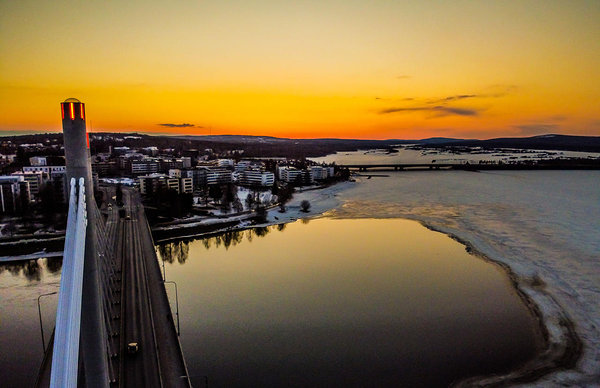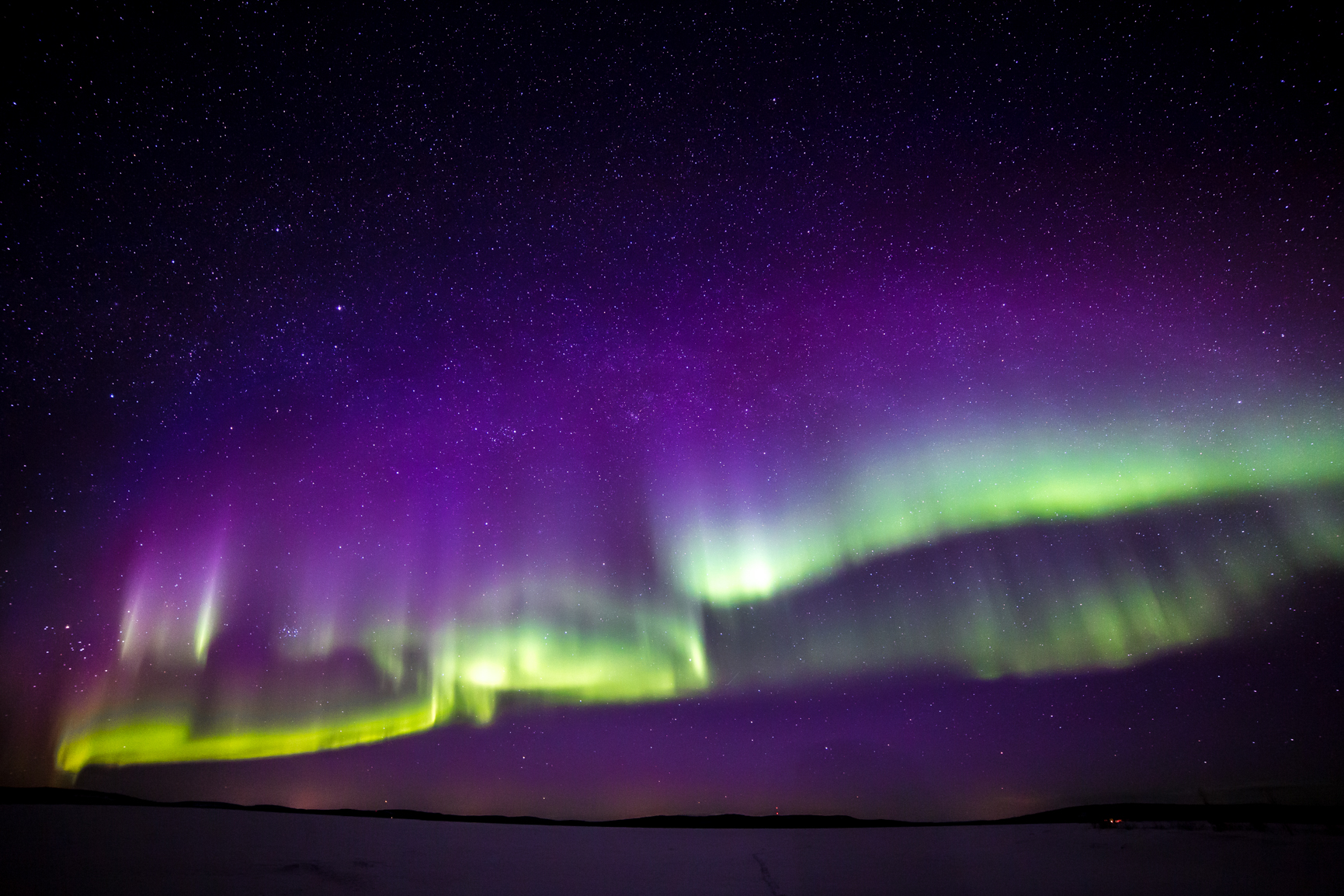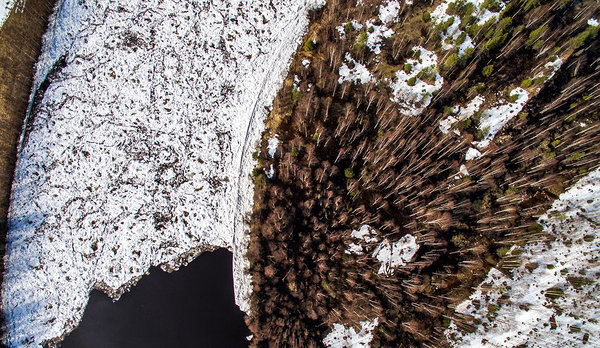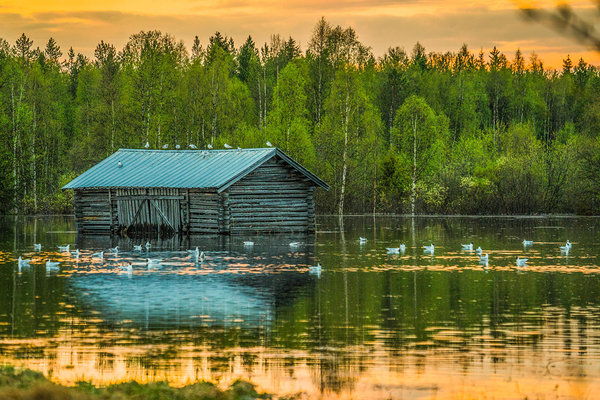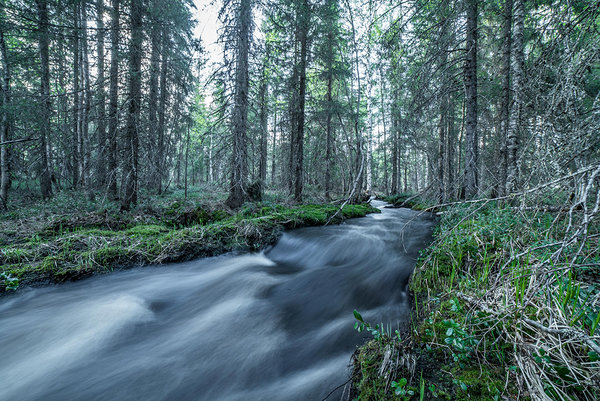Spring in Lapland – Time for Ice to break
Spring in Lapland is a thrilling period, when we face complete change of the nature and discover how summer is slowly overtaking winter. In springtime, rivers will drop their Ice cover, Snow will melt and finally plants and trees are pushing new growth.
Last light drops of Polar night
At the end of April, we witnessed last Northern Lights for this winter here in Lapland and it´s time to say farewell to them for now. It has been great Northern Lights season again here in Arctic and many of our guests have uncovered the magic of this Northern phenomenon, Aurora Borealis. The actual reason why we don't see Auroras in the late spring and summer is because of the Sun. Here in Arctic, the Sun doesn´t set too much below the horizon and for this reason it prevents us to see the Northern Lights. Simply said, it´s just too bright for us to see them. During the Arctic summer months (late May, June, July) we have the period of Midnight sun, which basically means that Sun will stay above the horizon 24 hours a day! Northern Lights are visible again in mid-August and we are always super excited to start a new Aurora season here in the Arctic!
Flooding Arctic
Usually early spring in Lapland signifies warm and sunny days, but still cold and dark nights. When the temperature rises high enough, also the Snow and Ice will start to melt naturally. First sunbeams will push snowbanks lower and lower, leaving lakes and rivers still good for Ice Fishing for example. Of course during the Spring you should not take unnecessary risks when walking on Ice, so better trust your local guide or use locations you can see other people around. If you´re not sure about walking on Ice, preferable do not go at all! Another winter and another layer of thick Ice will follow year after another anyway.
When Spring rushes forward, at some point it is not safe to walk on Ice anymore. When the Ice cover is thin enough, Ice will start to crack and pushes water on top of the Ice. This causes Ice to crack even more and will eventually break into smaller pieces. On rivers these pieces of ice will travel along the stream, trying to reach the sea before melting. Sometimes ice rafts will get stuck to an island and will cause a dam to block the river running freely. This takes effect so that the river up from the dam will start to flood!
Especially here in Finnish Lapland there´s a few well known rivers that are flooding regularly. Closest to Rovaniemi is river called Ounasjoki, which is known for its conventional springtime flooding. Sometimes the floods are so bad that buildings and houses close to river are left under water. This causes severe damage to the properties and is a challenging time for anyone who got their real estate wet.
Photographing the Flood
Because flooding period is so short and intense, you should be prepared and ready with your photography equipment at the time of the flooding. Normally, there´s only a few days to witness the peak before flood starts to decrease. So in this meaning, it is not reasonable to start ordering your ND-filters or other equipment online when you already see the water rising. Instead you need to be already prepared.
There´s a few things that makes flood so special to photograph. Firstly, the scenery you´re used to in your everyday morning walk next to a river will change a lot. Closest tree trunks will be sunk and scenery itself will seem pretty much more to a lake than a river. An extraordinary situation, right? Secondly, the Blocks of Ice floating down the river are fascinating to watch, photograph and specially to hear. Blocks are making this thunder kind of noise when they collide with each other. It´s a sound you can´t hear any other time of the year.
Techniques to Photograph the flood
When photographing the flood, already the flood itself is an impressive to take pictures of, but there´s one special technique to make photos even more expressive. For nice flood pictures, we could bring in long exposure photography. For long exposure photography you will need a DSLR camera, a tripod and a proper lens to use with the camera. As most likely you are on the go at daytime between morning twilight and dusk, it will require many stops in aperture to go higher when taking pictures during the day with the long exposure. Already with let´s say f/16 we can get started, but might want to go even higher to around f/22. Remember, higher you go with the aperture, more dust you will reveal in your censor. So keep your censor nice and clean as always.
When talking about the long exposure you definitely need a tripod for the camera. Otherwise pictures will jolt and all you will get is a blurry picture. Also a remote is advised to operate with your camera. An example setting for long exposure photography during the daytime would be aperture f/18 ISO 100 and shutter speed of 3”. This setting should already give you nice and steady flow for the river and make the stream look nice and smooth.
You can even decrease your shutter speed by using a Neutral-density or in other words an ND-filter on your lens. These ND-filters will allow you to go few steps lower with the shutter speed. Basically ND-filter can be compared to sunglasses, which will block light coming into the lens, just like sunglasses does to your eyes. There´s huge number of ND-filters in selections, but basically you can start with ND2 ND4 and ND8-filters. Number behind ND indicates how much light the filter passes into the camera. Higher the number, less light will travel through the filter. There´s filters even up to ND100000, but they are already pretty hardcore.
So at the very end, if you´re traveling in the Arctic and Finnish Lapland, don´t miss your chances to witness springtime floods. These floods have two opposite sides. The one that represents upcoming summer and new life forming along the warming days. And the one that indicates the power and capability of nature to demolish if it desires. An Absolute fact however is that spring floods are very impressive to oversee, and they stand for one of the most unique phenomena in the Arctic.
Juho Uurtamo
Photographer, Beyond Arctic
At the end of April, we witnessed last Northern Lights for this winter here in Lapland and it´s time to say farewell to them for now. It has been great Northern Lights season again here in Arctic and many of our guests have uncovered the magic of this Northern phenomenon, Aurora Borealis. The actual reason why we don't see Auroras in the late spring and summer is because of the Sun. Here in Arctic, the Sun doesn´t set too much below the horizon and for this reason it prevents us to see the Northern Lights. Simply said, it´s just too bright for us to see them. During the Arctic summer months (late May, June, July) we have the period of Midnight sun, which basically means that Sun will stay above the horizon 24 hours a day! Northern Lights are visible again in mid-August and we are always super excited to start a new Aurora season here in the Arctic!
Flooding Arctic
Usually early spring in Lapland signifies warm and sunny days, but still cold and dark nights. When the temperature rises high enough, also the Snow and Ice will start to melt naturally. First sunbeams will push snowbanks lower and lower, leaving lakes and rivers still good for Ice Fishing for example. Of course during the Spring you should not take unnecessary risks when walking on Ice, so better trust your local guide or use locations you can see other people around. If you´re not sure about walking on Ice, preferable do not go at all! Another winter and another layer of thick Ice will follow year after another anyway.
When Spring rushes forward, at some point it is not safe to walk on Ice anymore. When the Ice cover is thin enough, Ice will start to crack and pushes water on top of the Ice. This causes Ice to crack even more and will eventually break into smaller pieces. On rivers these pieces of ice will travel along the stream, trying to reach the sea before melting. Sometimes ice rafts will get stuck to an island and will cause a dam to block the river running freely. This takes effect so that the river up from the dam will start to flood!
Especially here in Finnish Lapland there´s a few well known rivers that are flooding regularly. Closest to Rovaniemi is river called Ounasjoki, which is known for its conventional springtime flooding. Sometimes the floods are so bad that buildings and houses close to river are left under water. This causes severe damage to the properties and is a challenging time for anyone who got their real estate wet.
Photographing the Flood
Because flooding period is so short and intense, you should be prepared and ready with your photography equipment at the time of the flooding. Normally, there´s only a few days to witness the peak before flood starts to decrease. So in this meaning, it is not reasonable to start ordering your ND-filters or other equipment online when you already see the water rising. Instead you need to be already prepared.
There´s a few things that makes flood so special to photograph. Firstly, the scenery you´re used to in your everyday morning walk next to a river will change a lot. Closest tree trunks will be sunk and scenery itself will seem pretty much more to a lake than a river. An extraordinary situation, right? Secondly, the Blocks of Ice floating down the river are fascinating to watch, photograph and specially to hear. Blocks are making this thunder kind of noise when they collide with each other. It´s a sound you can´t hear any other time of the year.
Techniques to Photograph the flood
When photographing the flood, already the flood itself is an impressive to take pictures of, but there´s one special technique to make photos even more expressive. For nice flood pictures, we could bring in long exposure photography. For long exposure photography you will need a DSLR camera, a tripod and a proper lens to use with the camera. As most likely you are on the go at daytime between morning twilight and dusk, it will require many stops in aperture to go higher when taking pictures during the day with the long exposure. Already with let´s say f/16 we can get started, but might want to go even higher to around f/22. Remember, higher you go with the aperture, more dust you will reveal in your censor. So keep your censor nice and clean as always.
When talking about the long exposure you definitely need a tripod for the camera. Otherwise pictures will jolt and all you will get is a blurry picture. Also a remote is advised to operate with your camera. An example setting for long exposure photography during the daytime would be aperture f/18 ISO 100 and shutter speed of 3”. This setting should already give you nice and steady flow for the river and make the stream look nice and smooth.
You can even decrease your shutter speed by using a Neutral-density or in other words an ND-filter on your lens. These ND-filters will allow you to go few steps lower with the shutter speed. Basically ND-filter can be compared to sunglasses, which will block light coming into the lens, just like sunglasses does to your eyes. There´s huge number of ND-filters in selections, but basically you can start with ND2 ND4 and ND8-filters. Number behind ND indicates how much light the filter passes into the camera. Higher the number, less light will travel through the filter. There´s filters even up to ND100000, but they are already pretty hardcore.
So at the very end, if you´re traveling in the Arctic and Finnish Lapland, don´t miss your chances to witness springtime floods. These floods have two opposite sides. The one that represents upcoming summer and new life forming along the warming days. And the one that indicates the power and capability of nature to demolish if it desires. An Absolute fact however is that spring floods are very impressive to oversee, and they stand for one of the most unique phenomena in the Arctic.
Juho Uurtamo
Photographer, Beyond Arctic
